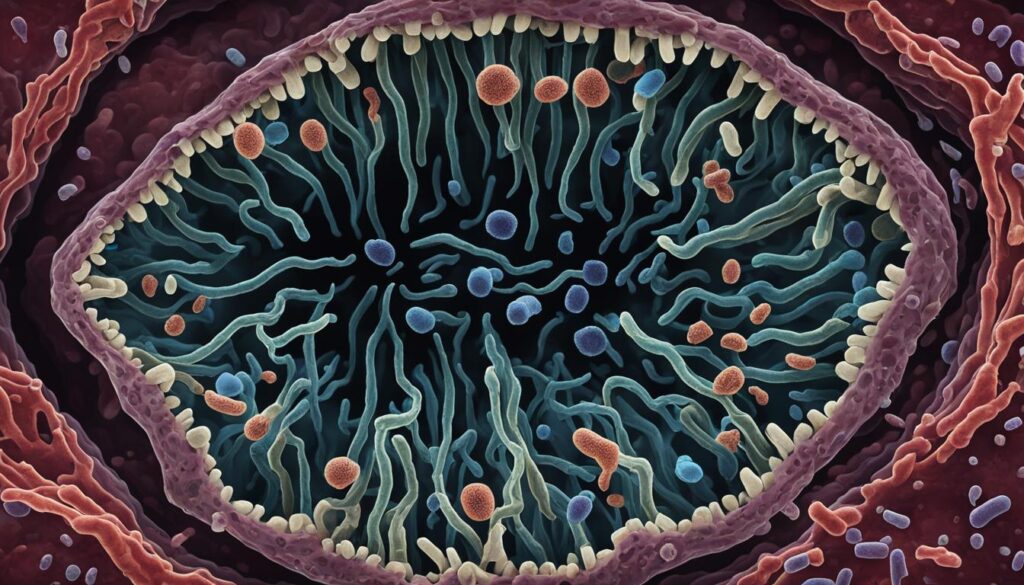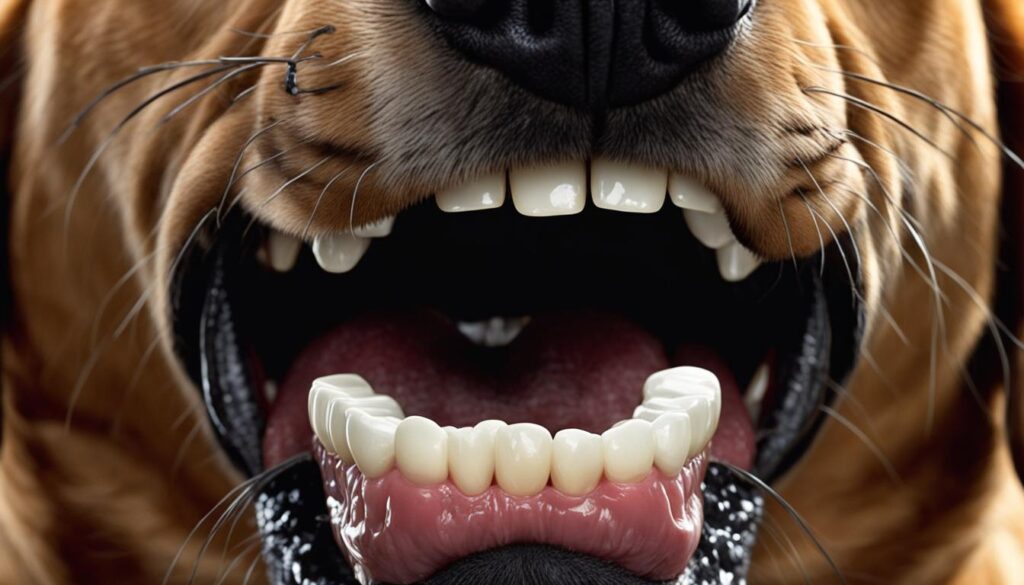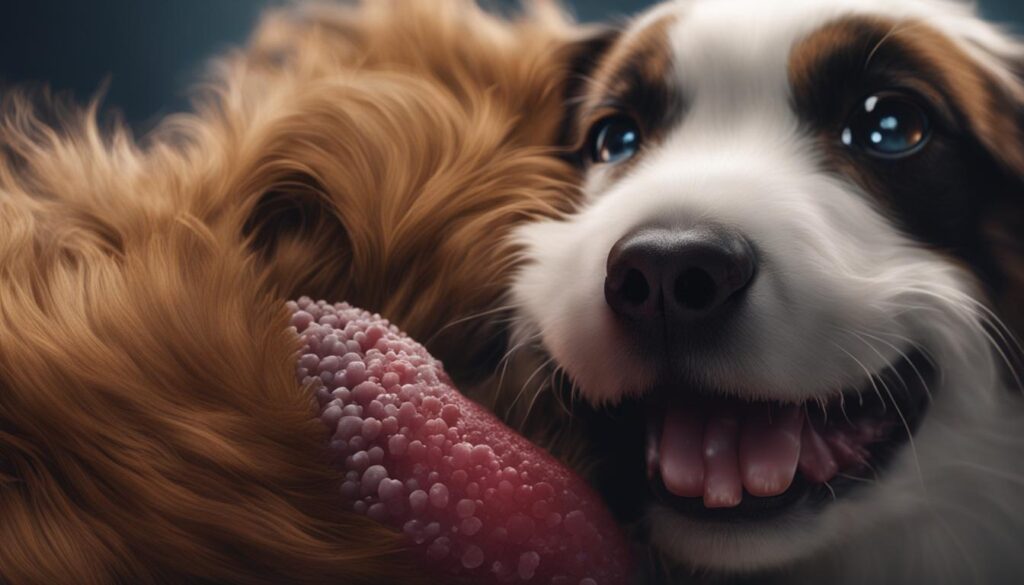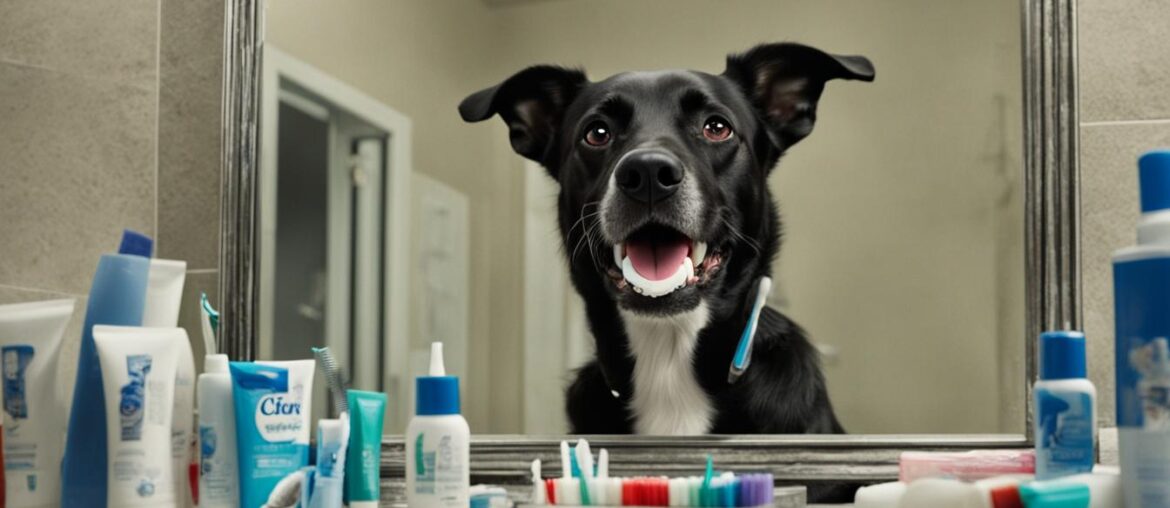When it comes to the cleanliness of a dog’s mouth, there are many misconceptions. Some believe that dogs have cleaner mouths than humans, but is this really true? In this article, we will explore the truth behind dog dental hygiene and oral health in dogs.
Contrary to popular belief, a dog’s mouth is not cleaner than a human’s mouth. Both contain a variety of microbes and bacteria that can cause dental disease. Comparing the two is like comparing apples and oranges, as dogs have different types of dental bacteria than humans.
Key Takeaways:
- Dogs do not have cleaner mouths than humans.
- Both dog and human mouths contain bacteria that can cause dental disease.
- Dogs have different types of dental bacteria than humans.
The Bacterial Differences Between Dog and Human Mouths

When it comes to the bacteria in dog mouths, it’s important to understand that dogs and humans have a similar number of bacterial types – over 600. However, the specific types of bacteria in dog mouths differ from those found in human mouths. This variation in bacterial composition is due to the differences in the oral environment and diet between dogs and humans.
Dogs have their own unique set of oral bacteria, including a type called Porphyromonas gulae, which is associated with periodontal disease in dogs. Periodontal disease is a common condition in dogs, characterized by the buildup of dental plaque and tartar, inflammation of the gums, and potential damage to the teeth and supporting structures. It is essential to address dental plaque in dogs to prevent the progression of gum disease and maintain their oral health.
To illustrate the bacterial differences between dog and human mouths, here is a comparison:
| Dog Mouth Bacteria | Human Mouth Bacteria |
|---|---|
|
|
While there are similarities in the bacterial communities, the specific types and proportions differ. Both dog and human mouths have the potential to harbor harmful bacteria that can contribute to dental plaque formation, gum disease, and other oral health issues if not properly managed.
It is important to note that dental plaque in dogs can progress to more severe forms of periodontal disease, leading to tooth loss and potential systemic health complications. Regular dental care, including professional cleanings and daily tooth brushing with dog-specific toothpaste, is crucial for maintaining oral hygiene and preventing gum disease in dogs.
Is Dog Saliva Beneficial for Wound Healing?

Dog saliva has long been associated with wound healing, and many people believe that a dog’s lick can magically heal a wound. While there may be some truth to this belief, it is important to understand the science behind it.
Dog saliva contains certain proteins called histatins, which have antibacterial and antifungal properties. These histatins can help ward off infection and promote the healing process. When a dog licks a wound, these proteins are transferred to the affected area, potentially reducing the risk of infection and accelerating healing.
Furthermore, the act of licking can help remove dirt and debris from the wound site, keeping it clean. When a dog licks, the rough texture of its tongue acts like a natural scrub brush, gently dislodging particles that may hinder the healing process.
However, it is important to exercise caution when relying solely on dog saliva for wound healing. While dog saliva does contain beneficial elements, it can also harbor harmful bacteria that can lead to serious infections if introduced into an open wound.
It is generally recommended to seek conventional medical care for wound treatment and use dog saliva as an adjunct rather than the primary method of wound healing. Your healthcare provider can provide proper wound care guidance and prescribe antibiotics if necessary.
It’s important to note that wound healing is a complex process that involves various factors such as the size and depth of the wound, the overall health of the individual, and the presence of underlying medical conditions. While dog saliva may have some positive effects on wound healing, it is not a miracle cure-all.
The Role of Oral Hygiene in Dogs and Humans
Both dogs and humans require regular oral hygiene practices to maintain clean and healthy mouths. This includes daily tooth brushing and dental cleanings. Good oral hygiene helps keep harmful bacteria in check and prevents dental disease in both dogs and humans.
Training dogs to enjoy tooth brushing from a young age is important, as it establishes a routine and allows for proper dental care. Using toothpaste specifically designed for dogs is essential, as human toothpaste may contain ingredients that can be harmful to dogs if ingested.
Regular tooth brushing removes plaque and tartar buildup, which can lead to gum disease, tooth decay, and bad breath. It also helps to prevent dental pain and discomfort that can affect a dog’s overall well-being.
Additionally, professional dental cleanings performed by a veterinarian are recommended to thoroughly clean and examine a dog’s teeth and gums. These cleanings can help identify and address any dental issues that may not be visible to the naked eye.
Proper dental care is equally important for humans. Regular tooth brushing, flossing, and dental check-ups help maintain oral hygiene and prevent dental diseases such as cavities, gum disease, and bad breath. Good oral health in humans also contributes to overall well-being and can prevent systemic health issues.
By prioritizing oral hygiene in both dogs and humans, we can ensure healthier mouths, happier lives, and stronger bonds between pets and their owners.
The Myth of Dogs Having the Cleanest Mouths

The belief that dogs have the cleanest mouths is a common misconception that has been perpetuated for years. This myth likely stems from the observation that dogs often lick their wounds, leading people to believe that their mouths must be cleaner than those of humans. However, the reality is quite different.
Dog mouths, like human mouths, harbor a variety of bacteria. While it’s true that dogs have their own unique bacteria, the idea that their mouths are cleaner is simply not accurate. In fact, dogs can carry harmful bacteria that can cause infections and dental diseases.
Dog mouth cleanliness is an important aspect of their overall health. Just as humans need to take care of their oral hygiene, dogs require regular cleaning and care to prevent dental issues and bad breath.
Can Humans Get Dog Germs?

While dogs can carry a variety of bacteria in their mouths, most of these bacteria are not zoonotic, meaning they cannot be transmitted to humans. However, there are exceptions to this rule.
- Zoonotic Diseases: Dogs fed a raw diet may have an increased risk of carrying harmful bacteria such as salmonella, which can be passed to humans. It is important to handle raw food safely and practice good hygiene when preparing and serving meals for your dog.
- Hygiene Practices: Practicing good hygiene is crucial to prevent the transmission of any potential pathogens between dogs and humans. This includes washing hands after touching a dog’s mouth or handling their food, and avoiding close contact if the dog has been exposed to potentially harmful substances or environments.
It’s important to note that while the risk of contracting zoonotic diseases from dogs is generally low, it is always advisable to consult with a healthcare professional if you have any concerns or if you or a family member are immunocompromised.
Comparing Dog, Human, and Cat Mouths

When it comes to the bacteria found in their mouths, dog, human, and cat mouths each have their unique characteristics. While dogs and humans have more differences in their oral microbiota, cats share a closer resemblance to dogs in terms of microbial composition.
Studies have shown that approximately 50% of the bacteria found in a dog’s mouth are also present in a cat’s mouth. This similarity suggests a shared microbial community between these two species. However, it’s important to note that cats typically have fewer types of bacteria in their mouths compared to both dogs and humans.
Understanding the microbial differences between these three species can provide valuable insights into their oral health and hygiene needs. By comparing and contrasting the bacteria present, researchers can develop effective strategies and treatments for maintaining clean and healthy mouths in dogs, cats, and humans.
| Dogs | Cats | Humans | |
|---|---|---|---|
| Number of Bacterial Types | Varied (>600 types) | Fewer types compared to dogs and humans | Varied (>600 types) |
| Bacterial Similarity to Dogs | About 50% | About 50% | N/A |
The Safety of Kissing Dogs

When it comes to showing affection to our furry friends, many of us can’t resist giving them a big kiss on the nose or the top of their head. But have you ever wondered about the safety of kissing dogs? While it is generally safe to engage in this loving gesture, there are a few factors to consider regarding dog mouth germs and the potential transmission of bacteria.
Dogs, like humans, naturally have bacteria in their mouths. However, the specific types of bacteria found in a dog’s mouth are typically different from those found in humans. The good news is that most of the bacteria found in a dog’s mouth are not transmissible to humans. Therefore, the risk of contracting any harmful dog mouth germs through kissing is relatively low.
That being said, it’s still essential to practice good hygiene when interacting with dogs. Keeping vaccinations up to date is vital not only for the dog’s health but also for reducing the risk of any potential infections. Additionally, controlling both external and internal parasites, such as fleas and ticks, is crucial for maintaining overall cleanliness and minimizing any potential germs that may be present.
While the risk of contracting harmful bacteria from kissing dogs is low, it’s important to be mindful of certain factors. If a dog has recently been exposed to potentially harmful substances or environments, it’s best to avoid close contact, including kissing, until the dog is thoroughly cleaned. Similarly, if you have an open wound or are immunocompromised, it’s advisable to refrain from kissing dogs to prevent any potential infections.
Ultimately, the safety of kissing dogs comes down to being aware of the potential risks and taking appropriate precautions. By practicing good hygiene, keeping vaccinations up to date, and monitoring the dog’s environment and cleanliness, you can enjoy those precious kisses with your furry companion while minimizing any possible transmission of dog mouth germs.
Comparing Dog Mouth Germs and Human Mouth Germs
| Types of Bacteria | Dog Mouth | Human Mouth |
|---|---|---|
| Porphyromonas | P. gulae | P. gingivalis |
| Streptococcus | S. canis | S. mutans |
| Fusobacterium | F. nucleatum | F. nucleatum |
While there are similarities in the types of bacteria found in both dog and human mouths, there are also distinct differences. Understanding these differences can help provide insights into the potential transmission of germs and emphasize the importance of good hygiene for both dogs and humans.
Image: A visual representation of the bacteria present in a dog’s mouth.
The Importance of Dental Treats for Dogs
Providing dental treats specifically designed for dogs can have a significant impact on their oral health and contribute to keeping their mouths clean and fresh. These treats offer a range of benefits, including the removal of plaque and tartar buildup and the freshening of breath. Incorporating dental treats into your dog’s routine can be a valuable addition to their overall dental care regimen, which includes regular tooth brushing and professional cleanings.
High-quality dental treats are formulated to promote healthy teeth and gums in dogs. They are designed to have a chewy texture that helps remove plaque and tartar as the dog chews, providing a mechanical cleaning action. Additionally, many dental treats contain ingredients that support oral health, such as enzymes that help break down plaque and reduce bacteria in the mouth.
When choosing dental treats for your dog, it is essential to consider the quality of the product. Look for treats that are made from natural ingredients and free from artificial colors, flavors, and preservatives. Your veterinarian can recommend specific brands or types of dental treats that suit your dog’s needs and preferences.
Incorporating dental treats into your dog’s routine can help complement other dental care practices, such as tooth brushing. While dental treats can provide some level of dental cleaning, they should not replace regular toothbrushing. Brushing your dog’s teeth with a dog-specific toothpaste is the most effective way to remove plaque and prevent dental issues.
Furthermore, professional dental cleanings performed by a veterinarian are crucial for maintaining optimal oral health in dogs. Regular check-ups help identify any oral health issues early on and allow for appropriate treatment. Your veterinarian may advise you on the frequency of dental cleanings based on your dog’s specific needs and oral health status.
Dental Treats Comparison Table
| Treat Brand | Features | Benefits |
|---|---|---|
| Brand A Dental Chews | Triple Action Formula: Cleans, Freshens, Strengthens | – Scrubs away plaque and tartar – Freshens breath – Promotes strong teeth and healthy gums |
| Brand B Dental Sticks | Low-Fat Recipe with Natural Ingredients | – Reduces plaque and tartar buildup – Supports dental health without excess calories – Delicious flavor dogs love |
| Brand C Dental Bones | Enriched with Calcium and Vitamins | – Helps maintain strong teeth – Provides essential nutrients for overall health – Promotes chewing for dental hygiene |
Regular use of dental treats, in conjunction with proper tooth brushing and professional cleanings, can significantly contribute to your dog’s oral health. Remember to consult with your veterinarian to develop a personalized dental care plan that suits your dog’s specific needs and ensures a lifetime of healthy teeth and gums.
Tips for Maintaining a Healthy Dog Mouth
To ensure a healthy dog mouth, it is essential to establish a daily dental care routine from a young age. By following a few simple tips, you can promote oral health and keep your furry friend’s breath fresh:
- Regular Tooth Brushing: Just like humans, dogs need their teeth brushed regularly to remove plaque and prevent tartar buildup. Use a toothbrush specifically designed for dogs and dog-friendly toothpaste. Aim for daily brushing, but if that is not feasible, aim for at least three times a week. Be patient and gentle, gradually introducing tooth brushing to your dog.
- Using Dog-Specific Toothpaste: Human toothpaste contains ingredients that are harmful to dogs when swallowed. Therefore, it is crucial to use toothpaste formulated specifically for dogs. These toothpastes come in flavors such as chicken or beef, making the experience more enjoyable for your furry friend.
- Providing Dental Treats: Dental treats can be a valuable addition to your dog’s oral care routine. These treats are designed to help remove plaque and tartar buildup while freshening breath. Look for high-quality dental treats that have the Veterinary Oral Health Council (VOHC) seal of approval.
- Regular Veterinary Check-Ups: Regular visits to the veterinarian are essential for maintaining your dog’s oral health. During these check-ups, the vet will assess your dog’s dental health and provide any necessary treatments or recommendations. The vet may also perform professional dental cleanings when needed.
- Professional Dental Cleanings: Professional dental cleanings, performed by a veterinarian, are crucial for maintaining optimal oral health in dogs. These cleanings involve removing plaque and tartar buildup that cannot be addressed through regular brushing alone. The frequency of professional cleanings will depend on your dog’s oral health needs, and your veterinarian will provide guidance.
If you have any concerns about your dog’s oral hygiene or notice signs of dental disease, such as bad breath, swollen gums, or difficulty eating, it is essential to consult with your veterinarian for personalized advice and treatment recommendations.
| Oral Care Tips for Dogs | Benefits |
|---|---|
| Daily Tooth Brushing | Removes plaque and prevents tartar buildup |
| Using Dog-Specific Toothpaste | Safe for dogs when swallowed |
| Providing Dental Treats | Helps remove plaque and freshens breath |
| Regular Veterinary Check-Ups | Assesses oral health and provides necessary treatments |
| Professional Dental Cleanings | Removes plaque and tartar buildup |
The Importance of Oral Hygiene for Overall Health
Good oral hygiene is crucial for both maintaining a clean mouth and ensuring overall health. This holds true for dogs as well, as poor dental health can have a significant impact on their overall well-being.
Poor oral hygiene in dogs can contribute to various health issues, including heart disease and kidney problems. The bacteria that thrive in an unhealthy mouth can enter the bloodstream and travel to other parts of the body, leading to inflammation and potentially causing or exacerbating systemic health conditions.
Regular dental care plays a vital role in preventing these complications and promoting your dog’s overall health. By keeping their teeth and gums clean and disease-free, you can significantly reduce the risk of oral infections spreading and impacting other body systems.
Implementing a consistent oral hygiene routine is key. This includes regular tooth brushing using dog-specific toothpaste and providing dental treats that help reduce plaque and tartar buildup. Additionally, scheduling regular check-ups with your veterinarian and investing in professional dental cleanings as needed will ensure your dog’s oral health is in optimal condition.
The Connection Between Oral Health and Systemic Health
The link between oral health and systemic health in dogs is well-established. Research has shown that dental disease, such as periodontal disease, can have wide-ranging effects on various organs and systems within the body.
Untreated dental infections can lead to inflammation, which can affect the cardiovascular system and contribute to conditions such as endocarditis and heart disease. Bacteria in the mouth can also enter the bloodstream and affect the kidneys, potentially leading to chronic kidney disease.
Furthermore, oral health issues can impact the respiratory system, causing respiratory infections and exacerbating conditions like pneumonia. The inflammatory response triggered by dental disease can also aggravate conditions such as arthritis or diabetes.
By prioritizing your dog’s oral hygiene, you can proactively safeguard their overall health and minimize the risk of these systemic health complications.
The Oral-Systemic Health Connection in Humans
The importance of oral hygiene for overall health is not limited to dogs. In humans, too, maintaining good oral health is crucial to prevent a host of systemic health problems.
Poor oral hygiene in humans has been linked to an increased risk of cardiovascular disease, diabetes, respiratory infections, and even certain types of cancer. The bacteria in the mouth can enter the bloodstream, causing inflammation and contributing to these systemic health conditions.
It is clear that oral health plays a vital role in overall health, both in dogs and humans. By prioritizing oral hygiene practices and seeking regular dental care, you can make a significant impact on your pet’s or your own well-being.
| Oral Health | Overall Health Complications |
|---|---|
| Periodontal disease | Heart disease, kidney problems |
| Oral infections | Respiratory infections |
| Inflammation | Arthritis, diabetes |
Investing in the oral health of your dog or yourself is an investment in overall well-being. By maintaining good oral hygiene practices and seeking regular dental care, you can help prevent oral infections, protect systemic health, and ensure a happy, healthy life.
Wrapping Up
In conclusion, it is a common misconception that dogs have cleaner mouths than humans. The truth is that both dogs and humans harbor a variety of bacteria and microbes in their mouths, which can lead to dental disease if not properly addressed. Comparing the oral hygiene of dogs and humans is like comparing apples and oranges, as they have different types of bacteria.
However, it is essential for both dogs and humans to prioritize proper oral hygiene practices to maintain clean and healthy mouths. This includes regular tooth brushing, professional dental cleanings, and the use of dental treats designed for dogs. These measures are crucial for promoting oral health and preventing dental diseases in dogs.
Remember, good oral hygiene not only benefits the mouth but also contributes to overall health. For dogs, poor dental health can have serious implications on their well-being, potentially leading to issues such as heart disease and kidney problems. By prioritizing regular dental care, we can ensure our furry friends have not only fresh breath but also a healthy and happy smile.
FAQ
Do dogs have cleaner mouths than humans?
Contrary to popular belief, a dog’s mouth is not cleaner than a human’s mouth. Both contain a variety of microbes and bacteria that can cause dental disease. Comparing the two is like comparing apples and oranges, as dogs have different types of dental bacteria than humans.
How many types of bacteria are found in a dog’s mouth?
Dogs have over 600 different types of bacteria in their mouths, similar to the number found in human mouths. However, the specific types of bacteria differ between species.
Does dog saliva have any benefits for wound healing?
Dog saliva does have certain proteins, called histatins, that can ward off infection and promote wound healing. The act of licking also helps remove dirt and debris from the wound site. However, it is important to exercise caution as dog saliva can contain harmful bacteria, such as Pasteurella, that can lead to serious infections if introduced into an open wound.
What oral hygiene practices should be followed for dogs and humans?
Both dogs and humans require regular oral hygiene practices to maintain clean and healthy mouths. This includes daily tooth brushing and dental cleanings. Training dogs to enjoy tooth brushing from a young age is important, and it is essential to use toothpaste specifically designed for dogs.
Why do people believe that dogs have the cleanest mouths?
The belief that dogs have the cleanest mouths likely stems from their practice of licking their wounds. While licking can have some benefits for wound healing, it is essential to remember that dog mouths contain a variety of bacteria that can be harmful. Additionally, both dogs and humans can pick up bacteria from their environments, further adding to the mix of microbes in their mouths.
Can humans get sick from dog germs?
Most of the bacteria in a dog’s mouth are not zoonotic, meaning they cannot be transmitted to humans. However, there are exceptions. Dogs fed a raw diet may be at an increased risk of carrying salmonella, which can be passed to humans. It is also important to practice good hygiene and avoid contact with a dog’s mouth if they have been exposed to potentially harmful substances or environments.
How does a cat’s mouth compare to a dog’s mouth?
The bacteria in a dog’s mouth is more different from a human’s mouth than a cat’s mouth. Cats have closer microbial similarities to dogs, with about 50% of the bacteria found in a dog’s mouth also present in a cat’s mouth. However, cats typically have fewer types of bacteria in their mouths compared to both dogs and humans.
Is it safe to kiss dogs?
While it is generally safe to kiss dogs, it is important to be aware that dogs can still transmit germs. However, the bacteria found in a dog’s mouth are usually not transmissible to humans. Good hygiene practices, such as keeping vaccinations up to date and controlling external and internal parasites, can help minimize any potential risks.
How can dental treats benefit a dog’s oral health?
Providing dental treats specifically designed for dogs can help promote oral health and keep their mouths clean and fresh. These treats can aid in removing plaque and tartar buildup, as well as freshen breath. It is important to choose high-quality dental treats and use them as part of a comprehensive dental care routine that includes regular tooth brushing and professional cleanings.
What tips can help maintain a healthy dog mouth?
To ensure a healthy dog mouth, it is recommended to establish a daily dental care routine from a young age. This includes regular tooth brushing, using dog-specific toothpaste, and providing dental treats. Regular veterinary check-ups and professional dental cleanings are also vital for maintaining oral health in dogs. If you have any concerns about your dog’s oral hygiene, consult with your veterinarian for personalized advice.
How does oral hygiene impact overall health in dogs?
Good oral hygiene is not only essential for maintaining a clean mouth but also for overall health. Poor dental health in dogs can contribute to various health issues, such as heart disease and kidney problems. Regular dental care can help prevent these complications and ensure your dog’s overall well-being.






